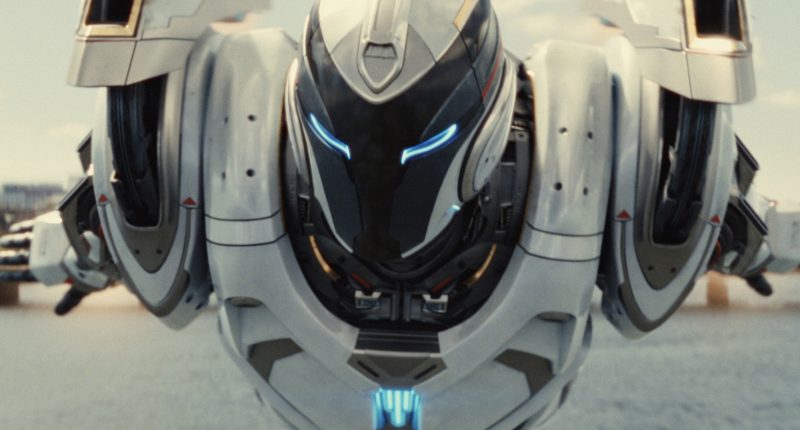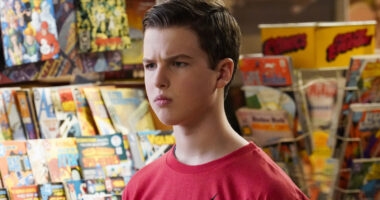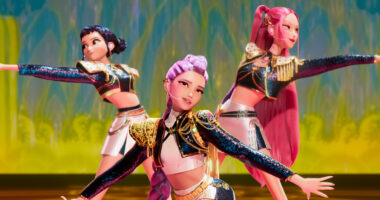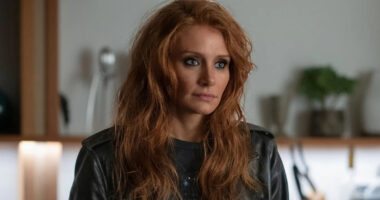Share this @internewscast.com
Contains spoilers for “Ironheart,” Episodes 1-6
The new Marvel series “Ironheart” wraps up with a dramatic cliffhanger, as Riri Williams/Ironheart (played by Dominique Thorne) defeats Parker Robbins/The Hood (Anthony Ramos) but then accepts a dark proposition from Mephisto (portrayed by Sacha Baron Cohen) to resurrect her friend Natalie (Lyric Ross). This intriguing ending hints at the potential direction for future “Ironheart” stories, whether in theater or on television, since Riri has now entwined her fate with Mephisto. However, the show’s hints extend beyond Riri Williams’ future adventures.
As with all Marvel Cinematic Universe ventures, “Ironheart” is filled with plot twists and dialogues that foreshadow significant upcoming events in the franchise. Clues about future TV series and films are subtly interwoven throughout the show’s six episodes, with five key hints varying in how they are embedded within the storyline.
Some teases involve the introduction of pivotal comic book figures like Mephisto. Others subtly suggest possible plot lines for emerging series that haven’t yet captured the public’s attention. There are also clear dialogues from essential supporting characters in “Ironheart,” clearly indicating their return in future MCU projects. No matter how they appear, these five elements of “Ironheart” underline how everything in the MCU is interconnected. As the old MCU adage says, “It’s all connected,” and the journey of Riri Williams/Ironheart is no exception to this intricate web.
The introduction of Mephisto
Years after endless speculation about whether or not “WandaVision” would feature the arrival of Mephisto – the Marvel version of the demon Mephistopheles – “Ironheart” turned out to be the Disney+/Marvel show that introduced this character into the MCU. After the first five “Ironheart” episodes hinted at his entrance through whispers swirling around The Hood’s head or a background poster advertising “Faust” (in which the title character is tempted by Mephistopheles), the supernatural villain finally appears in the last episode of “Ironheart.”
This episode begins with a lengthy flashback to Parker Robbins getting chased by the cops and needing a quick exit. At his lowest moment, Sacha Baron Cohen’s Mephisto appears and offers the guy a way out. From there, the duo have a chat, with Mephisto offering Robbins immense power in the form of a magical hood to achieve his dreams of becoming “filthy, disgusting rich.”
Once the finale returns to the present, Mephisto appears once more, this time sporting a British accent and a decidedly more hostile attitude. After Riri takes him down, this devilish figure offers to work with her in exchange for bringing Natalie Washington back to life. While it was always unlikely that Mephisto — a major antagonist in the comics — would be a one-and-done character in the MCU, Riri accepting his offer (and, in a final pre-credits shot, beginning to succumb to those malicious veins Robbins contended with) solidifies that he isn’t going anywhere. Any future MCU property dealing with magical entities, such as a potential third “Doctor Strange” movie, will also have to grapple with Mephisto’s immense power.
Parker Robbins yearns to learn magic
Like almost all MCU projects, “Ironheart” has a mid-credit scene teasing out future storylines. In this case, Parker Robbins strolls into a candy shop run by mother-daughter magic users Madeleine (Cree Summers) and Heather (Tanya Christensen). Riri and her mom previously explored this locale, and now Robbins is paying it a visit.
Deprived of his mystical hood, Robbins has no magical abilities. But as he explains to Heather, he’s willing to learn. The sequence ends by hinting that Heather will now train Robbins to become a sorcerer, which could allow Robbins to get revenge on Riri Williams even without his Mephisto-bestowed cloak. However, this scene does more than just suggest a potential plotline for Robbins in a second season of “Ironheart.”
Robbins specifically mentions, in talking to former Kamar-Taj student Heather, that he’s looking for “supreme” power through magical abilities. Using that term could hint that Robbins now has bigger targets in mind than just Riri. Perhaps he’s now aiming to become as powerful as the MCU’s current Sorcerer Supreme, Wong (Benedict Wong). Terror over powerlessness and a wish to usurp those in positions of power have motivated Robbins throughout “Ironheart,” and are now apparently driving him to expand his goals for revenge beyond CEOs working for his dad. With Heather’s teachings, Parker Robbins could become a magical force to be reckoned with.
Ezekiel Stane’s not done yet
After being introduced in Episode 2 of “Ironheart,” “Will the Real Natalie Please Stand Up?,” “Joe McGillicuddy”/Ezekiel Stane goes through a radical transformation over the next five episodes. Starting out as a mild-mannered suburbanite hiding lots of high-tech weaponry, the son of “Iron Man” baddie Obadiah Stane (Jeff Bridges) eventually gets framed for a break-in committed by Riri Williams, Parker Robbins, and their accomplices. This leads to Ezekiel getting stuck in a jail sentence that he only evades with the help of Robbins, who upgrades Ezekiel with robotic technology embedded inside his body.
Afrer Ezeziel is bestowed with bionic powers (and the unfortunate side effect of being controlled by Robbins), “Ironheart” ends with former pals Riri Williams and Ezekiel duking it out in a kitchen. Even after Riri releases Ezekiel from the control of Robbins, it’s clear this rivalry isn’t over. Ezekiel’s final “Ironheart” lines see him emphasizing to Riri that they’re not finished with each other. He’s still got so much rage inside that he’s going to channel it by enacting vengeance on this armored superhero.
Though it’s unknown for now where he’ll appear next in the MCU, it’s clear that the morally complicated Ezekiel will return to terrorize superheroes again soon. However, there isn’t just potential villainy in his future. Given how “Thunderbolts*” was all about anti-heroes and villains getting a second chance, Ezekiel may even score an opportunity to redeem himself. One thing’s for certain: Ezekiel Stane’s story has only begun in “Ironheart.”
There may be ripple effects on other Iron Man-adjacent projects
To ensure that “Ironheart” doesn’t just come off as an “Iron Man” knock-off, the show makes sure to interlace with MCU properties beyond the original three “Iron Man” movies. While Ezekiel Stane provides a concrete link between “Ironheart” and Tony Stark/Iron Man’s (Robert Downey Jr.) first movie, “Ironheart” also connects to the magic-based exploits of “Doctor Strange,” while also constantly referencing the events of “Black Panther: Wakanda Forever,” which featured the debut of Riri Williams and her iron suit.
However, now that “Ironheart” is finished, it’s doubtful this show can stay separated from other MCU productions spinning out of Tony Stark’s legacy. That could include 2026’s “Vision Quest,” a solo show for Paul Bettany’s Vision that promises to feature villains like James Spader’s Ultron and Faran Tahir’s Raza. Given that Vision himself started life as Stark’s A.I., JARVIS, it’s not impossible to imagine that the MCU’s Iron Man successor gets at least a “Vision Quest” shout-out.
Meanwhile, if the shelved “Armor Wars” solo movie, a proposed star vehicle for Don Cheadle’s Colonel James “Rhodey” Rhodes, ever comes to fruition, it could totally lean on the aftermath of “Ironheart” to signify what happens when Stark’s tech ends up in unpredictable hands. Tony Stark may be deceased, but he lives on through “Ironheart” and the MCU properties it could influence.
It foreshadows Doctor Doom’s powers
Back when “Ironheart” started shooting in the summer of 2022, the fifth solo “Avengers” movie was still titled “Avengers: The Kang Dynasty.” Kang the Conqueror was the future of the MCU and Doctor Doom would be saved for another day. By the time “Ironheart” actually hit Disney+, all Kang plans had been scrapped and that “Avengers” installment is now called “Avengers: Doomsday,” starring Robert Downey Jr. as Victor Von Doom/Doctor Doom.
At the premiere of “Ironheart,” executive producer Ryan Coogler observed that this turned out to be a fortuitous turn of events since it means “Ironheart” establishes a concept key to Doom’s character. By the end of the show, Riri Williams has fully intertwined Kamar-Taj magic with her iron suit to defeat Parker Robbins/The Hood. Fantastical concepts like spells are now ingrained into a technological corner of the MCU.
As Coogler explained, Doctor Doom is also a tech-based character who utilizes magic to realize his evil plans. This means “Ironheart” establishes a precedent for combining magic and technology even before Doctor Doom saunters into the franchise. Granted, Coogler’s comments didn’t clarify if Doom’s use of magic would visually evoke the depiction of tech-based sorcerer in “Ironheart,” nor was there any clarification of whether Riri would be invited to this big superhero showdown. But through unforeseen circumstances, “Ironheart” still ended up being a critical precursor to “Avengers: Doomsday” in establishing how technology and magic can work together.








